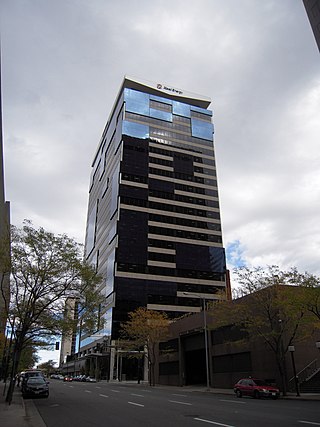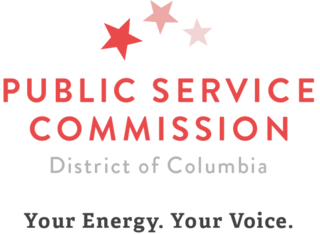
A public utility company is an organization that maintains the infrastructure for a public service. Public utilities are subject to forms of public control and regulation ranging from local community-based groups to statewide government monopolies.

Net metering is an electricity billing mechanism that allows consumers who generate some or all of their own electricity to use that electricity anytime, instead of when it is generated. This is particularly important with renewable energy sources like wind and solar, which are non-dispatchable. Monthly net metering allows consumers to use solar power generated during the day at night, or wind from a windy day later in the month. Annual net metering rolls over a net kilowatt-hour (kWh) credit to the following month, allowing solar power that was generated in July to be used in December, or wind power from March in August.

Xcel Energy Inc. is a U.S. regulated electric utility and natural gas delivery company based in Minneapolis, Minnesota, serving more than 3.7 million electric customers and 2.1 million natural gas customers across parts of eight states. It consists of four operating subsidiaries: Northern States Power-Minnesota, Northern States Power-Wisconsin, Public Service Company of Colorado, and Southwestern Public Service Co.

The Consumer Federation of America (CFA) is a non-profit organization founded in 1968 to advance consumer interests through research, education and advocacy.

The State Corporation Commission, or SCC, is a Virginia (USA) regulatory agency whose authority encompasses utilities, insurance, state-chartered financial institutions, securities, retail franchising, and railroads. It is the state's central filing office for corporations, limited partnerships, limited liability companies and Uniform Commercial Code liens.

A regional transmission organization (RTO) in the United States is an electric power transmission system operator (TSO) that coordinates, controls, and monitors a multi-state electric grid. The transfer of electricity between states is considered interstate commerce, and electric grids spanning multiple states are therefore regulated by the Federal Energy Regulatory Commission (FERC). The voluntary creation of RTOs was initiated by FERC in December 1999. The purpose of the RTO is to promote economic efficiency, reliability, and non-discriminatory practices while reducing government oversight.

The District of Columbia Public Service Commission is an independent quasi-judicial body and regulatory agency responsible for regulating landline telephone, electricity, and gas utility companies operating within the District of Columbia. It was established by the US Congress in 1913.
The Florida Public Service Commission (FPSC) regulates investor-owned electric, natural gas, and water and wastewater utilities. The FPSC facilitates competitive markets in the telecommunications industry, has authority over intercarrier disputes, and oversees pay telephones, the federal Lifeline Assistance Program and Telecommunications Relay Service.

Community Choice Aggregation (CCA), also known as Community Choice Energy, municipal aggregation, governmental aggregation, electricity aggregation, and community aggregation, is an alternative to the investor-owned utility energy supply system in which local entities in the United States aggregate the buying power of individual customers within a defined jurisdiction in order to secure alternative energy supply contracts. The CCA chooses the power generation source on behalf of the consumers.

The smart grid is an enhancement of the 20th century electrical grid, using two-way communications and distributed so-called intelligent devices. Two-way flows of electricity and information could improve the delivery network. Research is mainly focused on three systems of a smart grid – the infrastructure system, the management system, and the protection system. Electronic power conditioning and control of the production and distribution of electricity are important aspects of the smart grid.

The National Rural Water Association (NRWA), with its affiliated state rural water associations, is the largest water and wastewater utility membership organization in the United States of America. The NRWA is a professional organization that supports rural and small water utilities throughout the nation. NRWA and its state affiliates are organized as a non-profit trade association, and represent more than 31,000 water and wastewater utility members.
The National Propane Gas Association (NPGA) is an American trade association representing and advocating on behalf of the U.S. propane and renewable propane industries. Propane has a low-carbon content, has no methane emissions, is nontoxic, and is designated an approved clean, alternative fuel under the Clean Air Act Amendments.
The American Council for an Energy-Efficient Economy (ACEEE) is a nonprofit, 501(c)(3) organization. Founded in 1980, ACEEE's mission is to act as a catalyst to advance energy efficiency policies, programs, technologies, investments, and behaviors in order to help achieve greater economic prosperity, and environmental protection.
There is a large array of stakeholders that provide services through electricity generation, transmission, distribution and marketing for industrial, commercial, public and residential customers in the United States. It also includes many public institutions that regulate the sector. In 1996, there were 3,195 electric utilities in the United States, of which fewer than 1,000 were engaged in power generation. This leaves a large number of mostly smaller utilities engaged only in power distribution. There were also 65 power marketers. Of all utilities, 2,020 were publicly owned, 932 were rural electric cooperatives, and 243 were investor-owned utilities. The electricity transmission network is controlled by Independent System Operators or Regional Transmission Organizations, which are not-for-profit organizations that are obliged to provide indiscriminate access to various suppliers to promote competition.

Cedar Falls Utilities (CFU) is a municipally-owned public utility serving Cedar Falls, Iowa and is a member of the Iowa Association of Municipal Utilities (IAMU). CFU provides municipal water service, electricity generation and distribution, natural gas service, and combined cable television, Internet access, and phone service to its customers. CFU serves approximately 19,000 Cedar Falls residents and businesses with over 14,900 broadband customers.

A community solar project, farm or garden is a solar power installation that accepts capital from and provides output credit and tax benefits to multiple customers, including individuals, businesses, nonprofits, and other investors. Participants typically invest in or subscribe to a certain kW capacity or kWh generation of remote electrical production. The project's power output is credited to investors or subscribers in proportion to their investment, with adjustments to reflect ongoing changes in capacity, technology, costs and electricity rates. Community solar provides direct access to the renewable energy to customers who cannot install it themselves. Companies, cooperatives, governments or non-profits operate the systems.

EPB of Chattanooga, formerly known as the Electric Power Board of Chattanooga, is an American electric power distribution and telecommunication company owned by the city of Chattanooga, Tennessee. EPB serves nearly 180,000 homes and businesses in a 600-square mile area in the greater Chattanooga area and Hamilton County. In 2010, EPB was the first company in the United States to offer 1 Gbit/s high-speed internet over a fiber optic network, over 200 times faster than the national average. As a result, Chattanooga has been called "Gig City" and held up as a national model for deploying the world's fastest internet and the most advanced Smart Grid electric distribution system in the United States. On October 15, 2015, Chattanooga implemented the world's first community-wide 10-gig Internet service.
Smart grid policy in the United States refers to legislation and other governmental orders influencing the development of smart grids in the United States.

The Kansas City Board of Public Utilities (BPU) is a publicly owned, not-for-profit public utility servicing Wyandotte County that is headquartered in Kansas City, Kansas. Overall, BPU provides service to 127.5 square miles of Wyandotte County. Electric services are provided within the Kansas City, Kansas (KCK) area, and water is supplied to KCK, as well as portions of suburban Wyandotte, Leavenworth, and Johnson counties.

A mini-grid is an aggregation of electrical loads and one or more energy sources operating as a single system providing electricity and possibly heat, isolated from a main power grid. A modern mini-grid may include renewable- and fossil fuel-based power generation, energy storage, and load control. A mini grid can be fully isolated from the main grid or interconnected to it. If it is interconnected to the main grid, it must also be able to isolate (“island”) from the main grid and continue to serve its customers while operating in an island or autonomous mode. Mini-grids are used as a cost-effective solution for electrifying rural communities where a grid connection is challenging in terms of transmission and cost for the end user population density, with mini-grids often used to electrify rural communities of a hundred or more households that are 10 km or more from the main grid.















